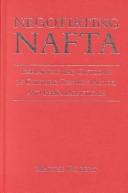| Listing 1 - 1 of 1 |
Sort by
|

ISBN: 9786612028571 128202857X 1442677600 9781442677609 9781282028579 0802043488 0802081703 9780802043481 9780802081704 6612028572 Year: 2016 Publisher: Toronto : University of Toronto Press,
Abstract | Keywords | Export | Availability | Bookmark
 Loading...
Loading...Choose an application
- Reference Manager
- EndNote
- RefWorks (Direct export to RefWorks)
International negotiations have become an important feature of the world trading system, but very few scholars have attempted to analyse this process. Using case studies in four areas - culture, textiles and apparel, autos, and pharmaceuticals - negotiated in the North American Free Trade Agreement (NAFTA), Maryse Robert uses a theoretical framework to help explain the outcome of such negotiations in terms of structure and process that. The structure of negotiations relates to states' objectives, outcomes, resources (in industry and in government), and issue-specific power. Process involves state's behaviour as expressed by its tactics during negotiation. Among the questions the author raises are: How are winning and losing defined in a given issue area? What are a state's resources as it enters a trade negotiation? Are all resources equally important? Is the utility of some tactics linked to certain resources? The key message of the book is that it is the right mix of resources and tactics that determines the outcome of negotiation. Very few scholars have attempted to analyse trade negotiations. Using case studies in four areas - culture, textiles and apparel, autos and pharmaceuticals - Robert proposes a theoretical framework to help explain the outcome of a negotiation in the field of international trade. She argues that this outcome has two characteristics: structure and process. The former is constituted of the resources a state brings to the table in a given issue area; the latter refers to the state's behaviour as expressed by its tactics during negotiation. The key message of the book is that it is the right mix of resources and tactics that determines the outcome.
Free trade --- Canada. --- Canada --- Commercial policy. --- North American Free Trade Agreement --- E-books --- NAFTA --- Tratado Trilateral de Libre Comercio --- TTLC --- Tratado de Libre Comercio en América del Norte --- TLCAN --- Tratado de Libre Comercio de Norteamérica --- Hokubei Jiyū Bōeki Kyōtei --- Acordo Norte-Americano de Livre Comércio --- T.L.C. --- TLC --- Accord de libre-échange nord-américain --- ALENA --- Tratado de Libre Comercio --- Agreement between Canada, the United States of America, and the United Mexican States --- Tratado de Libre Comercio de América del Norte --- United States-Mexico-Canada Agreement --- North American Free Trade Agreement (1992 December 17) --- North American Free Trade Agreement (1992 October 7) --- Treaties, etc. (Canada : 1992 October 7) --- Treaties, etc. (Mexico : 1992 October 7) --- Treaties, etc. (United States : 1992 October 7) --- North American Free Trade Agreement (1992) --- NAFTA (1992) --- Tratado Trilateral de Libre Comercio (1992) --- TTLC (1992) --- Tratado de Libre Comercio en América del Norte (1992) --- Tratado de Libre Comercio de América del Norte (1992) --- TLCAN (1992) --- Tratado de Libre Comercio de Norteamérica (1992) --- Hokubei Jiyū Bōeki Kyōtei (1992) --- Acordo Norte-Americano de Livre Comércio (1992) --- Nordamerikanische Freihandelszone (1992) --- T.L.C (1992) --- TLC (1992) --- Accord de libre-échange nord-américain (1992) --- ALENA (1992) --- Tratado de Libre Comercio (1992) --- Treaties, etc. (Canada : 1992 Oct. 7) --- Treaties, etc (Canada : 1992 Oct. 7) --- Treaties, etc (Canada : 1992) --- Treaties, etc (Canada)
| Listing 1 - 1 of 1 |
Sort by
|

 Search
Search Feedback
Feedback About
About Help
Help News
News